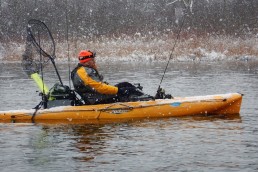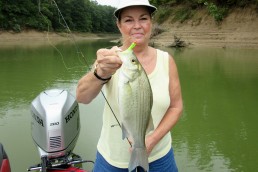Cold-water Spinnerbait Fishing Techniques
SHARE THIS POST
On one of my first fishing outings last spring I located a massive school of pre-spawn largemouths and smallmouths holding over a huge shallow weed flat shortly after ice out. The water was still too cold, in the mid to high 40s, for any bass to venture inward to build spawning nests and begin their annual breeding period. Successive cold snaps combined with overcast weather kept the water temp down, setting up a classic offshore staging pattern. Few anglers tap into this pattern, but it is there for the taking if you know what to look for.
One of the most predictable locations for offshore early spring cold-water bass is the immediate area just outside where bass are sure to spawn when the water warms. In other words, when they aren’t on the bank, simply turn around and cast the other way! In some cases, this is a large flat area with scattered weed growth, but on clear waters that lack cover, it might be a nearby reef, or a breakline with man-made fish cribs on it. Any point that has an underwater bar extension on it is likely to hold a school of anxious bass, too. Take time to explore some of these offshore spots until you encounter a bass or two. Once you connect, slow down and really check out everything nearby. Eventually, you will discover a gold mine of opportunity. That is when cold-water spinnerbait fishing shines.
Crankbaits are a favored lure for probing early pre-spawn bass, but weed cover, grassy clumps and woody bottoms might suggest trying a spinnerbait instead. High weed growth, in particular, makes it difficult to effectively work crankbaits adorned with treble hooks over the target area without constantly fouling with grass. Add turbid water and lower clarity common to many waters in the springtime and jigs and weedless soft plastics become less productive.
Turbid waters call for vibration and that spells s-p-i-n-n-e-r-b-a-i-t. The vibe and thump of a blade is often essential. However, not just any spinnerbait will do in these circumstances. Early season bass in cold water rarely respond favorably to a hot retrieve and a high-riding bait. So the conventional 1/4- to 3/8-ounce long arm tandem apparatus commonly sold on most sporting goods shelves is simply not the right tool for the job here. That style of spinnerbait simply runs too high in the water column for cold-water, bottom-hugging bass. One sporting a heavier lead head along with a shorter wire arm and a single small blade is sure to be far more effective.
Adding a lively soft plastic grub tail to the hook on a spinnerbait, a plastic tail that wiggles well at slow speeds is a big plus for this cold water crawling technique. Typically, I like a 3.5 to 4 inch paddle tail style grub, but the traditional curly grub works well, too. In fact, quite often I actually fish my spinnerbaits at this time of year without a conventional skirt of any kind—no skirt at all. In other words, take the skirt off and simply thread on a grub. Essentially, the lure ends up looking like a jig and grub with an additional wire arm. This setup, while odd looking, can be the ultimate cold water bass killer.
Removing the skirt from a spinnerbait takes away buoyancy allowing the lure to travel deeper on the retrieve, which is often critical to success. One can crawl this modified spinnerbait slowly up and down over weeds as well as inch it steadily along the bottom much like swimming or dragging a jig. Yet, you will still feel that spinner blade thumping along. Feeling that thump of the blade, by the way, is key. Adjust your retrieve speed so you can feel the thump of the blade, but barely.
Are you enjoying this post?
You can be among the first to get the latest info on where to go, what to use and how to use it!
Simply slow it down or even let it sink all the way to the bottom when encountering deeper holes, pockets or dropoffs. This technique is now a big part of my cold-water game when filming early season TV segments. In fact, quite often now I will cast this unique heavy weight spinnerbait setup out over deep water and let it plummet to the bottom just like a standard jig. Once my line goes slack, I lift up on the rod and aggressively turn the reel handle a few times to get the blade pulsing. Several times throughout the retrieve I abruptly stop cranking and let the lure flutter back downward until the line goes slack. Some of my biggest bass have englulfed the lure at this juncture in the technique.
When it comes to tackle, I usually throw the heavyweight, cold-water spinnerbait on a baitcasting outfit loaded with braided line in the 15- to 20-pound range. A stouter rod action and some additional length improves your feel for this technique as well. Extra long casts are recommended here too, enabling you to cover more water and allow the bait more room to pendulum on a tight line towards the bottom. In fact, you are bound to get quite a few strikes while letting the lure sink downward like a jig. The key is to keep your line tight so the lure doesn’t tumble. This positions the spinnerbait nicely so the blade helicopters on the drop. Once you score with this technique, you’ll become a big fan in no time.
Visit Joe Bucher’s YouTube channel at fishingwithjoebucher.com. A library of subject-specific videos are available, including one for this article.
Author Joe Bucher with a big early-season smallmouth that fell for a deep, hard-thumping presentation. The right tool for the job, he says, is a heavy spinnerbait with a relatively short arm and single, small spinner blade.
MWO
SHARE THIS POST
Did you enjoy this post?
You can be among the first to get the latest info on where to go, what to use and how to use it!
Joe Bucher
Joe Bucher is a Freshwater Fishing Hall of Fame Legendary Angler, book author, lure designer and host of Fishing with Joe Bucher TV series.



